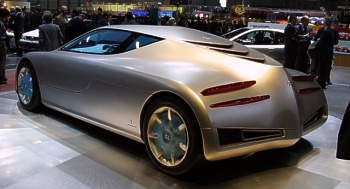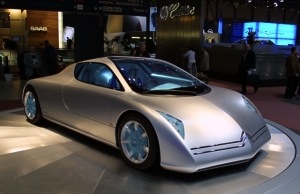
.
. .
.. . . .
. .
Other Pininfarina Other Engineering Companies & Coachbuilder
© 1998 - 2005
Copyright & |
. Pininfarina: OSEE
Photo: Automotive Intelligence This proposal has never been attempted in mass production, and increases the visual impact of the show car, paying homage to the many prototypes that introduced it in the 1960s.
This is briefly the background to the project; the brand philosophy, the strong historical styling cues, the car's architecture and geometry. But the Pininfarina design team had another important objective. The spirit with which an independent design house tackles a project is very different from that of a car maker's own in-house designers. The latter's skill lies in continuing to interpret and develop brand styling through its models. The skill of the independent designer, on the contrary, is to come up with specific shapes for the various makes for which he works, according to his own aesthetic and creative vision. And he is more successful in the extent to which his personal vision adapts and enhances the characteristics of each different make. Less than a year after the realisation of the "rossa" research prototype, conceived around the Ferrari image and therefore aggressive, complex, plastic and muscular, Pininfarina decided to tackle the topic of the extreme sports car from CitroŽn's angle, which is totally different: rarefied, threadbare, almost minimalist, but also perfectly in line with Pininfarina's basic esthetical vision.
On the other hand, the surfaces that clothe these proportions are simple and clean, resting on three longitudinal ribs, one at the centre and two at the sides, which incline inwards like the canvas wings of a biplane. The central rib creates a "spinal cord" effect that runs from the double chevron of the nose, through the cabin to the rear, almost harking back to a "bateau" body with a shape like a ship's poop. The side is deliberately smooth, with no additional movements or sculpted elements that would spoil or interrupt it. Smooth surfaces, a slightly pointed nose and sides descending towards the rear are typical features of the DS and SM, the models taken as paragons of modern CitroŽn design. The nose has a rounded section which links smoothly up with the upper and lower parts of the car. The air intake is symbolised by the narrow slits that start from the CitroŽn logo at the centre of the car. A second air intake is camouflaged in the lower part, in the best brand tradition. The continuous, rounded surface of the nose conveys an impression of protection and softness rather than cutting aggressiveness. The triangular light clusters accompany the logo and underline the longitudinal lines of the car's structure. The windscreen emerges from the wide, short bonnet, with a continuous cut up to the roof. The edge of the window terminates with a slit that supplies the engine air intake. The continuous horizontal surface of the roof tapers off in the plan view, to create a sharp vertical volume that is another strong point of the car. The air outlets of the engine bay are built into the roof surface, continuing the arrow shaped cut of the windscreen, and reiterating the chevron motif in the plan view. Another characteristic strong point is the treatment of the rear volumes where the tapered cabin creates two large surfaces which widen towards the rear and link up to the roof. In the three-quarters view, the "crest" of the cabin and the large, rear mounted wings are much in evidence. To allow access to the interior, the entire superstructure of the cabin is lifted up by a hydraulic system activated by remote control. The interior conveys the same philosophies: pioneering flight, the materials, the central spinal cord. The three passengers are seated in a triangle to make better use of transverse space. Because it is a pure sports car, the central role of the driving position is emphasized both physically and ideally. The driver is seated on a very essential shell anchored to the car. The steering wheel and pedals are both adjustable. The offset side seats are treated "mimetically" compared to the rest of the environment. The facia is made of a tubular element that crosses the car, on which the functional elements are clustered. A textile surface, a sail or a wing, is stretched on this structure, visibly reiterating the entire design philosophy. One precise condition of the project was the complete break between the architecture of the OS…E and that of any other CitroŽn of today. As a result, the chassis was built specifically, integrating two fundamental elements of CitroŽn:
It is important to underline that this feature, the perception of almost leaving the ground, as in a flight simulator, made possible by the hydroactive suspension even on a high performance car, could represent the great quality and peculiarity of a true CitroŽn sports car, just as Pininfarina imagined it. Sometimes it is enjoyable to do something unexpected: to dare in other words, hence the choice of the name OS…E ("daring") for the new Pininfarina research prototype, the first to be conceived on CitroŽn mechanicals. It is a styling study that develops the theme of the pure mid-engined sports car, a new layout and concept for the French Company but realized with full respect for CitroŽn's philosophy and image. Photos: Pininfarina
|









